National Meteorological and Hydrological Services (NMHSs) throughout the Pacific Islands region are mandated by their governments to regularly produce country-specific long range climate forecasts and disseminate these to their national stakeholders. The resources shown below aid this process by providing regularly-updated global- and regional-scale climate model output, analysis tools, and consensus-based forecast and validation products.
Recent Updates
PICOF-14 regional statement (issued April 2024)
Pacific Islands Climate Change Monitor (2021)
Tropical Cyclone Outlook: November 2024-April 2025
WMO Products and Services
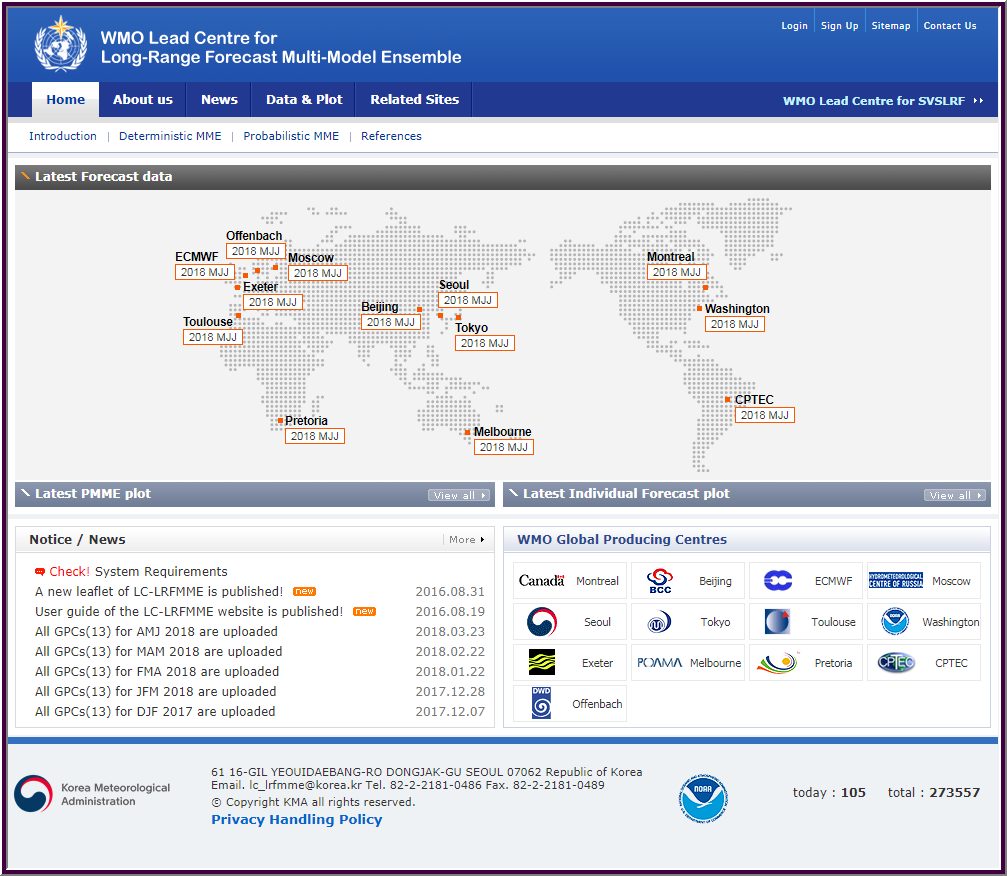 The World Meteorological Organisation Lead Centre for Long Range Forecast Multi-Model Ensemble has the objective to reduce the socio-economic losses associated with seasonal climate variability, and protect life and property. With this in mind, the Lead Centre for LRFMME has as its main goal the pooling and sharing of GPC forecast information in order to increase the reliability of LRF.
The World Meteorological Organisation Lead Centre for Long Range Forecast Multi-Model Ensemble has the objective to reduce the socio-economic losses associated with seasonal climate variability, and protect life and property. With this in mind, the Lead Centre for LRFMME has as its main goal the pooling and sharing of GPC forecast information in order to increase the reliability of LRF.
WMO Global Seasonal Climate Update - WMO has a new flagship product, Global Seasonal Climate Update (GSCU), which has been developed building upon the success of the WMO El Niño/La Niña Updates for over more than a decade. The GSCU summarizes the current status and expected future behavior of seasonal climate in terms of major general circulation features and large-scale oceanic anomalies around the globe (e.g., ENSO, NAO, IOD, etc.), and discusses briefly their likely impacts on continental scale temperature and precipitation patterns.
 WMO Global Annual to Decadal Climate Update for 2021 to 2025 - This update presents a summary of annual to decadal predictions from the WMO designated Global Producing Centres and other contributing centres for the period 2021-2025.
WMO Global Annual to Decadal Climate Update for 2021 to 2025 - This update presents a summary of annual to decadal predictions from the WMO designated Global Producing Centres and other contributing centres for the period 2021-2025.
Global Producing Centre (GPC) Products
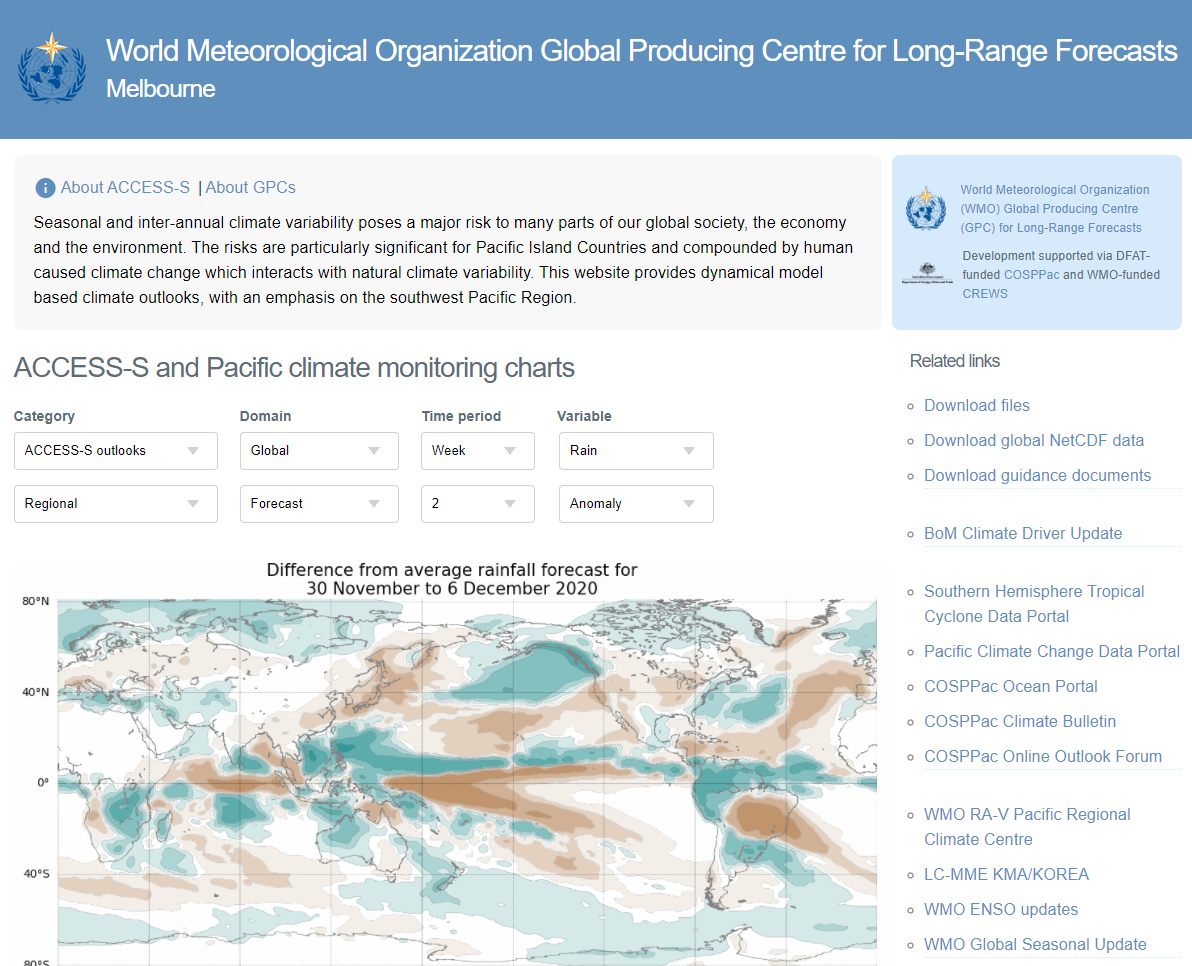
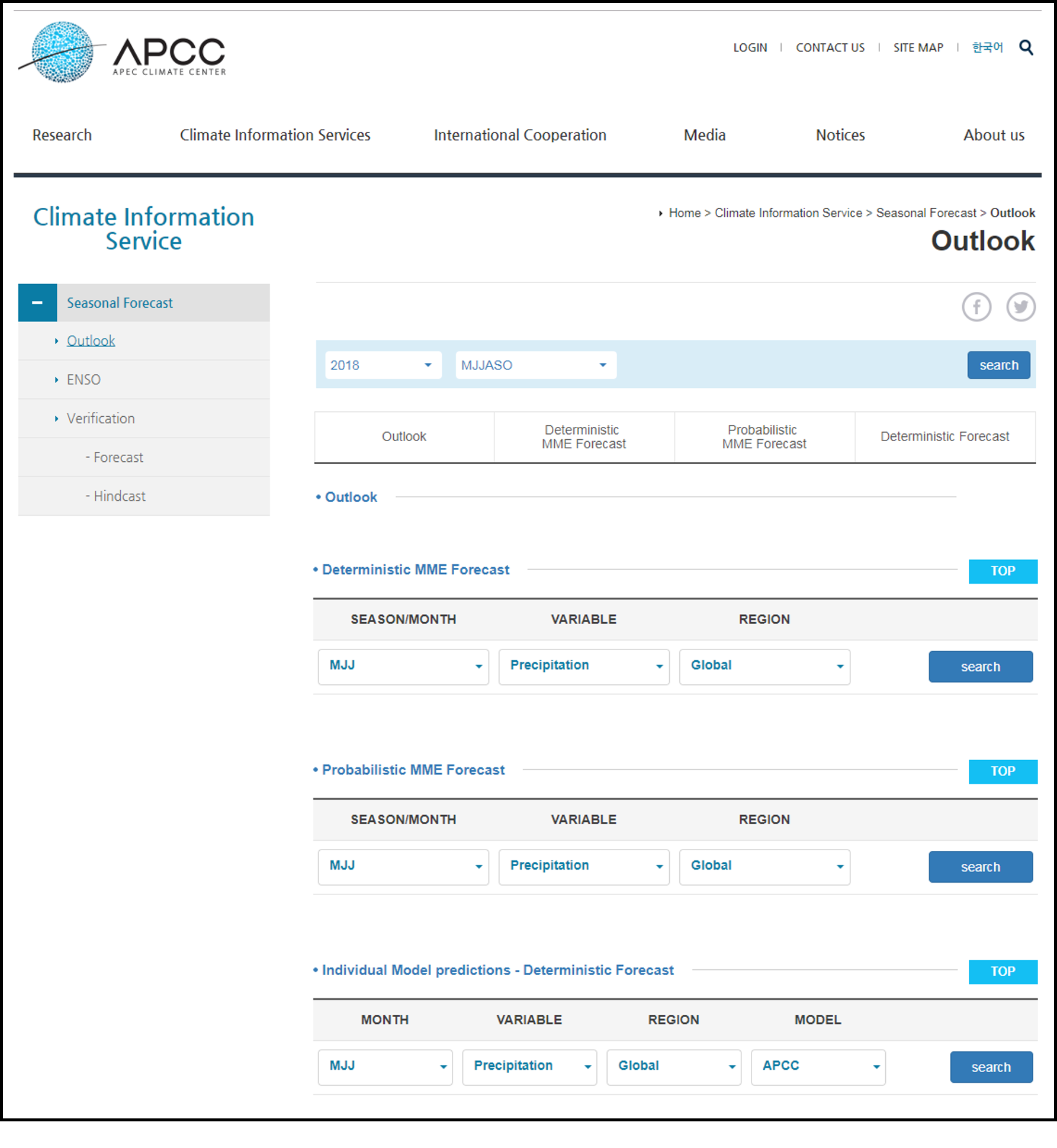 The APEC Climate Center (APCC) Climate Information Service includes a synthesis of the latest global model forecasts for the next six months. The service includes multi-model ensemble probabilistic and deterministic forecasts and verification diagnostics.
The APEC Climate Center (APCC) Climate Information Service includes a synthesis of the latest global model forecasts for the next six months. The service includes multi-model ensemble probabilistic and deterministic forecasts and verification diagnostics.
Tailored Regional LRF Products and Services
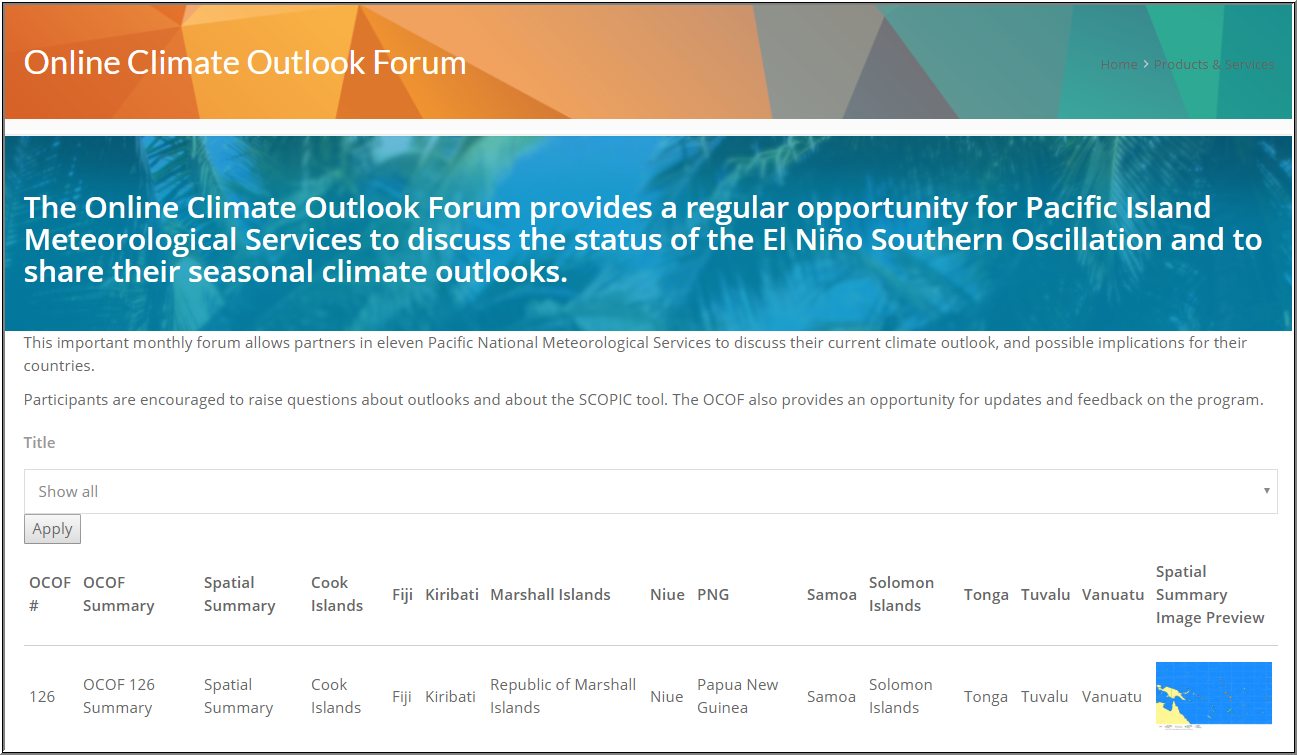 The Online Climate Outlook Forum (OCOF) allows partners in 11 Pacific Island NMHSs to validate their previous climate outlook, discuss their current climate outlook, and the possible implications for their countries. Participants are encouraged to raise questions about outlooks and about the SCOPIC tool (see below). The OCOF also provides an opportunity to discuss updates and get feedback.
The Online Climate Outlook Forum (OCOF) allows partners in 11 Pacific Island NMHSs to validate their previous climate outlook, discuss their current climate outlook, and the possible implications for their countries. Participants are encouraged to raise questions about outlooks and about the SCOPIC tool (see below). The OCOF also provides an opportunity to discuss updates and get feedback.
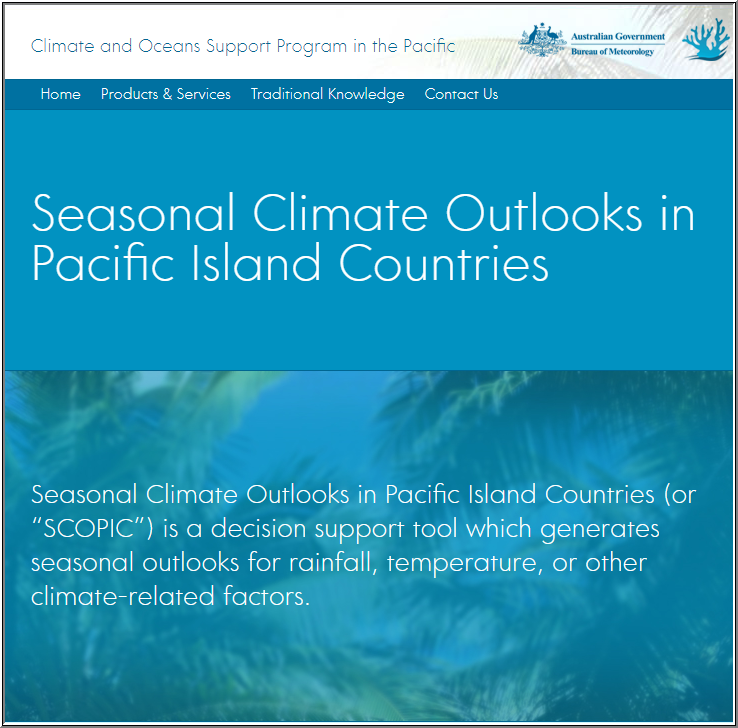 Seasonal Climate Outlooks for Pacific Island Countries (SCOPIC) was developed to provide Pacific Island nations with an accessible, stand-alone seasonal climate prediction system. The software uses a statistical method to determine forecast probabilities, based on historic data, and provides graphics and text to support the outlooks, including skill tests, hindcasts, data-browsing, statistical analyses, scatter plots, and drought monitoring.
Seasonal Climate Outlooks for Pacific Island Countries (SCOPIC) was developed to provide Pacific Island nations with an accessible, stand-alone seasonal climate prediction system. The software uses a statistical method to determine forecast probabilities, based on historic data, and provides graphics and text to support the outlooks, including skill tests, hindcasts, data-browsing, statistical analyses, scatter plots, and drought monitoring.
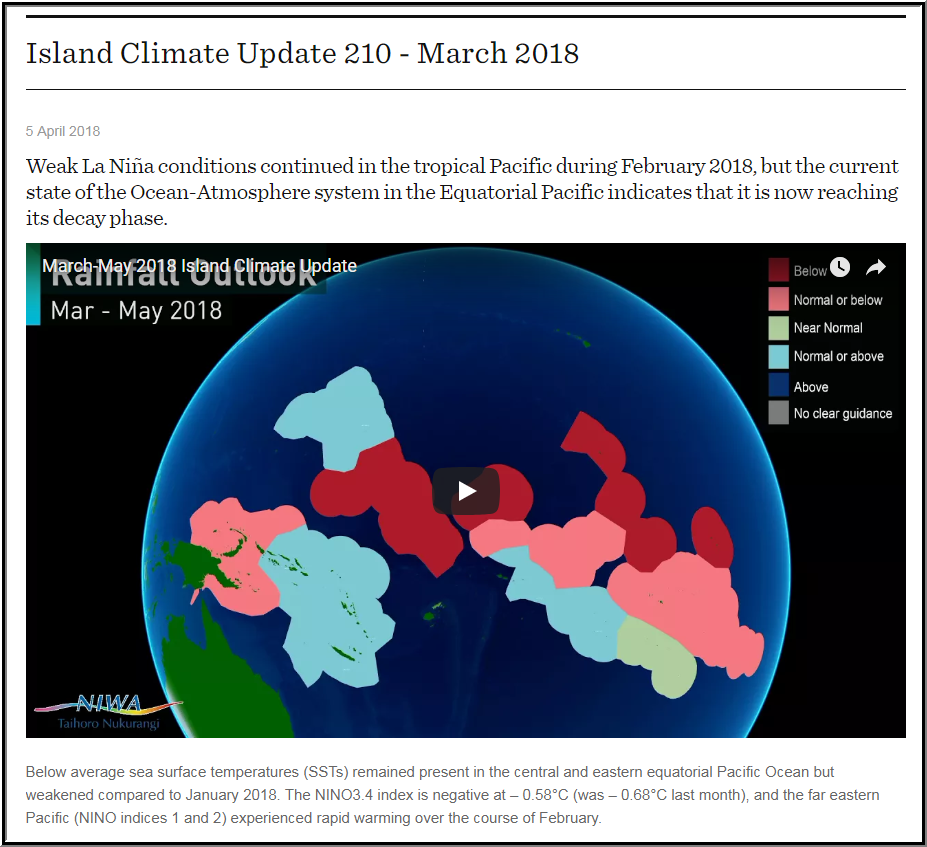 The Island Climate Update (ICU) is a monthly summary of the climate in the tropical South Pacific islands, with an outlook for the coming months. This bulletin is a multi-national project with collaboration from a number of Pacific nations and support from various organisations.
The Island Climate Update (ICU) is a monthly summary of the climate in the tropical South Pacific islands, with an outlook for the coming months. This bulletin is a multi-national project with collaboration from a number of Pacific nations and support from various organisations.
 CLIKⓟ (CLimate Information toolKit Pacific) is a regionally tailored online tool for Pacific Islands Countries and Territories. CLIKⓟ provides Pacific oriented information using the multi model dynamical seasonal forecast based on different combinations of the user's preference. As the forecasts are combined with the past performance of each forecast generated, climate forecasters, disaster managers, water resource managers, researchers, and other users in the Pacific, can use this service to generate customized climate predictions on seasonal to inter-annual timescales for their region of interest.
CLIKⓟ (CLimate Information toolKit Pacific) is a regionally tailored online tool for Pacific Islands Countries and Territories. CLIKⓟ provides Pacific oriented information using the multi model dynamical seasonal forecast based on different combinations of the user's preference. As the forecasts are combined with the past performance of each forecast generated, climate forecasters, disaster managers, water resource managers, researchers, and other users in the Pacific, can use this service to generate customized climate predictions on seasonal to inter-annual timescales for their region of interest.
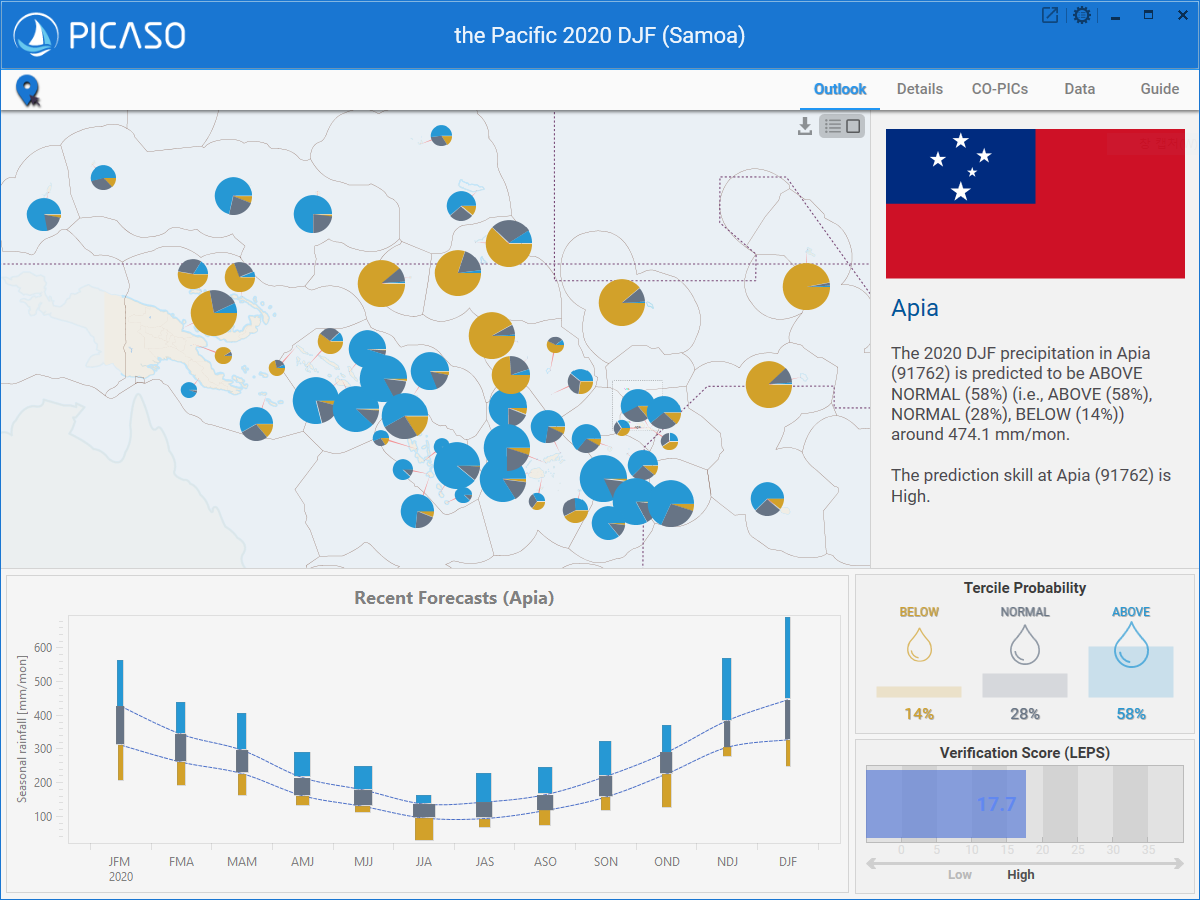
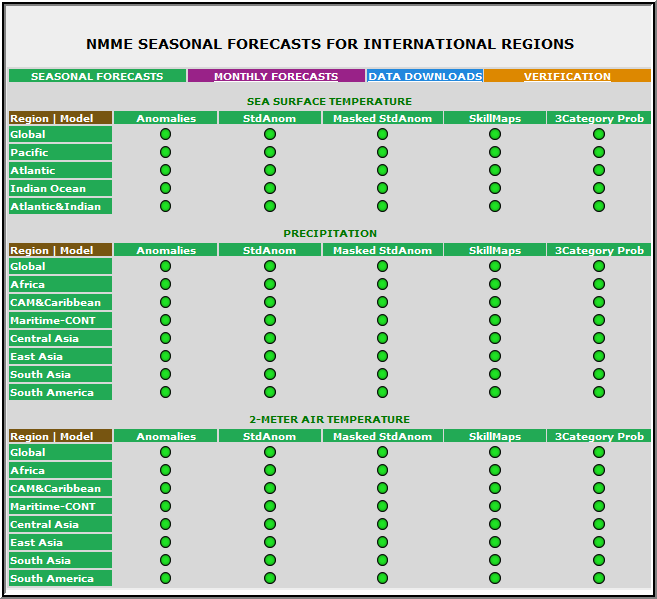 The North American Multi-Model Ensemble (NMME) seasonal forecasts for the global regions include the Pacific and Maritime Continent regions. The NMME models include the CFSv2, Environment Canada's CanCM4i, NOAA’s Geophysical Fluid Dynamic (GFDL), National Aeronautics and Space Administration (NASA), the National Center for Atmospheric Research (NCAR), and the ensemble mean of all the models.
The North American Multi-Model Ensemble (NMME) seasonal forecasts for the global regions include the Pacific and Maritime Continent regions. The NMME models include the CFSv2, Environment Canada's CanCM4i, NOAA’s Geophysical Fluid Dynamic (GFDL), National Aeronautics and Space Administration (NASA), the National Center for Atmospheric Research (NCAR), and the ensemble mean of all the models.
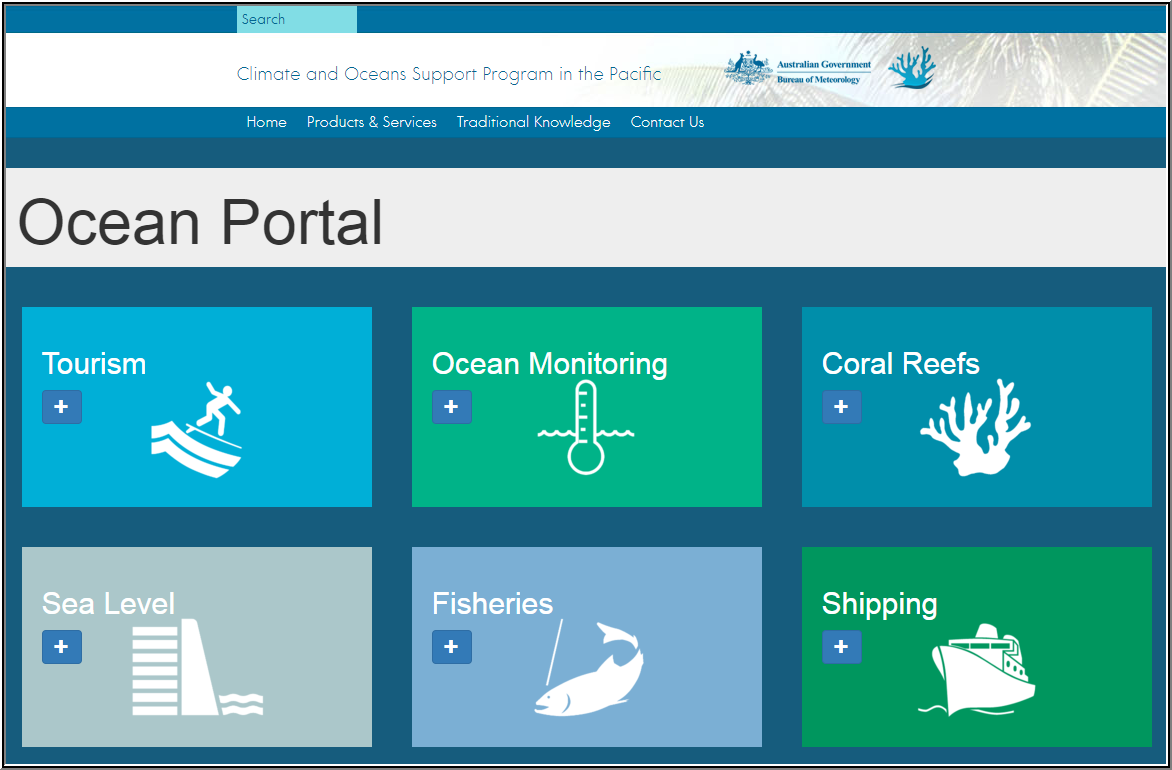 Sea level and sea surface temperature (SST) anomaly outlooks are available through the Pacific Ocean Portal. Both products are produced from the BoM POAMA model. SST forecasts in degrees Celsius are available in the “Fisheries” application.
Sea level and sea surface temperature (SST) anomaly outlooks are available through the Pacific Ocean Portal. Both products are produced from the BoM POAMA model. SST forecasts in degrees Celsius are available in the “Fisheries” application.
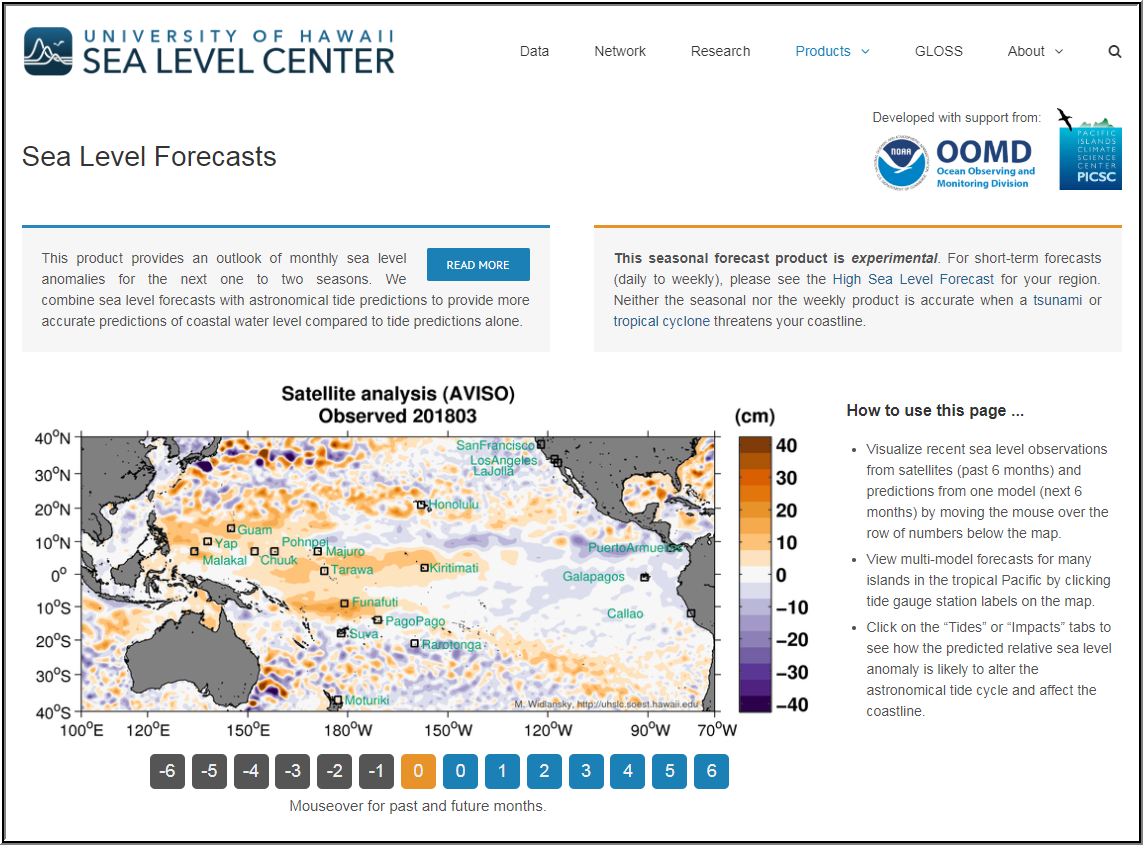 The Pacific Sea Level Ensemble Forecast product provides an outlook of monthly sea level anomalies for the next one to two seasons. We combine sea level forecasts with astronomical tide predictions to provide more accurate predictions of coastal water level compared to tide predictions alone. NOTE: This seasonal forecast product is experimental.
The Pacific Sea Level Ensemble Forecast product provides an outlook of monthly sea level anomalies for the next one to two seasons. We combine sea level forecasts with astronomical tide predictions to provide more accurate predictions of coastal water level compared to tide predictions alone. NOTE: This seasonal forecast product is experimental.
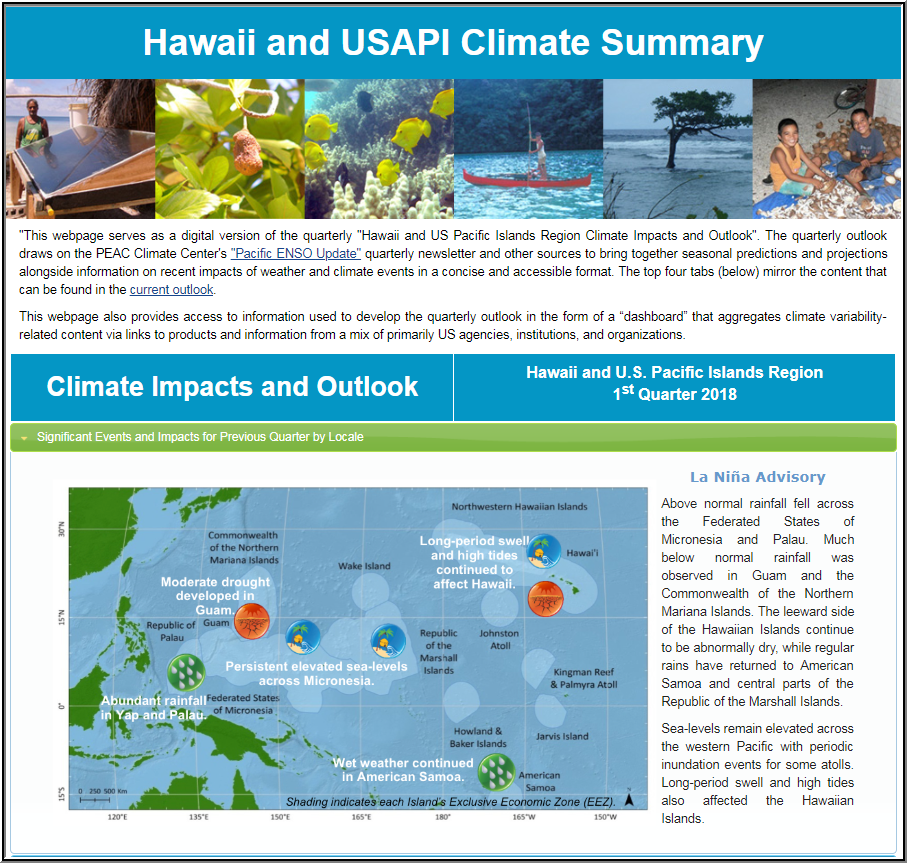 The quarterly Hawaii and US Pacific Islands Region Climate Impacts and Outlook draws on the Pacific ENSO Applications Climate (PEAC) Center's Pacific ENSO Update quarterly newsletter and other sources to bring together seasonal predictions and projections alongside information on recent impacts of weather and climate events in a concise and accessible format.
The quarterly Hawaii and US Pacific Islands Region Climate Impacts and Outlook draws on the Pacific ENSO Applications Climate (PEAC) Center's Pacific ENSO Update quarterly newsletter and other sources to bring together seasonal predictions and projections alongside information on recent impacts of weather and climate events in a concise and accessible format.
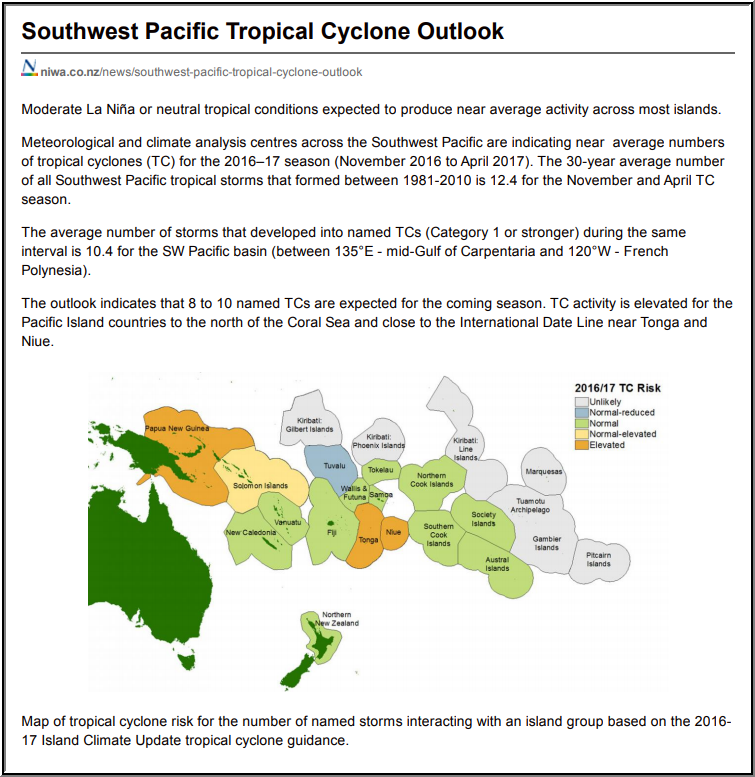 An annual tropical cyclone outlook, issued in early October, is prepared by New Zealand’s National Institute of Water & Atmospheric Research (NIWA) and Meteorological Service of New Zealand (MetService) along with meteorological forecasting organisations from the Southwest Pacific, including the Australian Bureau of Meteorology, MeteoFrance and the Pacific Island National Meteorological Services.
An annual tropical cyclone outlook, issued in early October, is prepared by New Zealand’s National Institute of Water & Atmospheric Research (NIWA) and Meteorological Service of New Zealand (MetService) along with meteorological forecasting organisations from the Southwest Pacific, including the Australian Bureau of Meteorology, MeteoFrance and the Pacific Island National Meteorological Services.
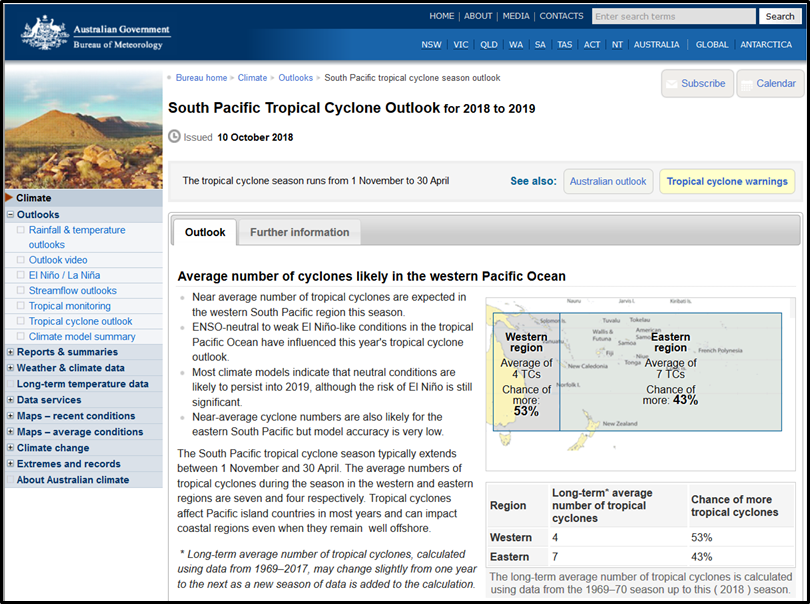 The Bureau of Meteorology (BoM) South Pacific Tropical Cyclone Outlook is a forecast of the average numbers of tropical cyclones during the period 1 November to 30 April for the western and eastern South Pacific regions. Tropical cyclones affect Pacific Island countries in most years and can impact coastal regions even when they remain well offshore.
The Bureau of Meteorology (BoM) South Pacific Tropical Cyclone Outlook is a forecast of the average numbers of tropical cyclones during the period 1 November to 30 April for the western and eastern South Pacific regions. Tropical cyclones affect Pacific Island countries in most years and can impact coastal regions even when they remain well offshore.
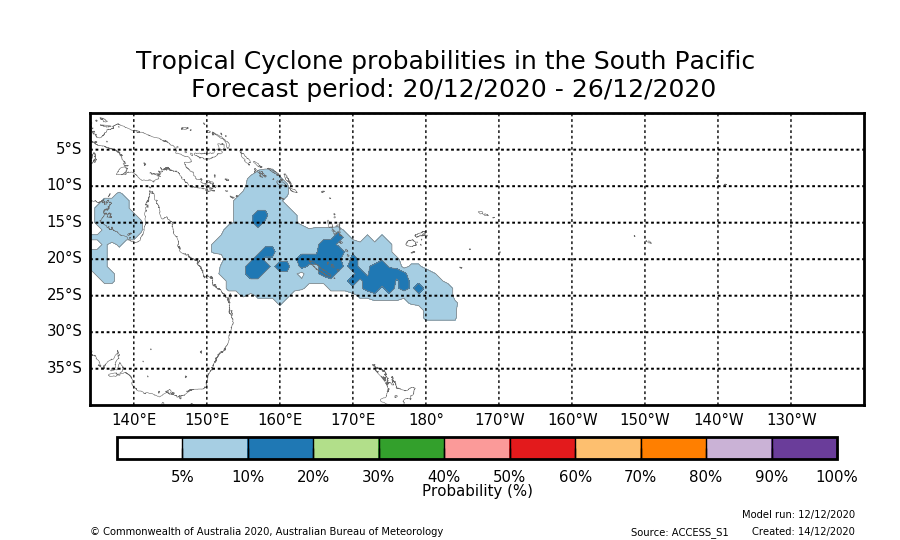 The Bureau of Meteorology (BoM) ACCESS-S Tropical Cyclone forecast of the probability of tropical cyclones during the week 2 and 3 of each month for the northwest and southwest Pacific.
The Bureau of Meteorology (BoM) ACCESS-S Tropical Cyclone forecast of the probability of tropical cyclones during the week 2 and 3 of each month for the northwest and southwest Pacific.
Consensus Statements and Feedback
A consensus statement on the state of the El Niño Southern Oscillation (ENSO), the annual tropical cyclone outlook, the regional climate outlook for the coming six months, and the risk of impacts associated with this forecast is prepared annually at the Pacific Islands Climate Outlook Forum (PICOF).
In addition, the preparation of the Online Climate Outlook Forum (OCOF), Island Climate Update (ICU), and Hawaii and US Pacific Islands Region Climate Impacts and Outlook involve a teleconference-based consensus process.
The annual PICOF and monthly or seasonal teleconferences also provide opportunities for members of Pacific Islands National Meteorological and Hydrological Services (NMHSs) to discuss the utility of the global- and regional-scale data, tools, products and services for the generation of their own national-scale climate forecasts.
Furthermore, the PICOF also serves as a regional feedback mechanism for Pacific Island countries' sector representatives, who are the primary stakeholders of the national forecast products, to discuss how they use the information and how it could be better tailored to meet their specific needs.
RCC LRF Node Leads: NIWA and BoM
Consortium members: Meteo-France, NOAA, Univeristy of Hawaii, SPREP and SPC

